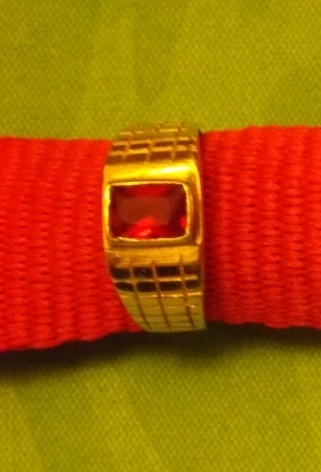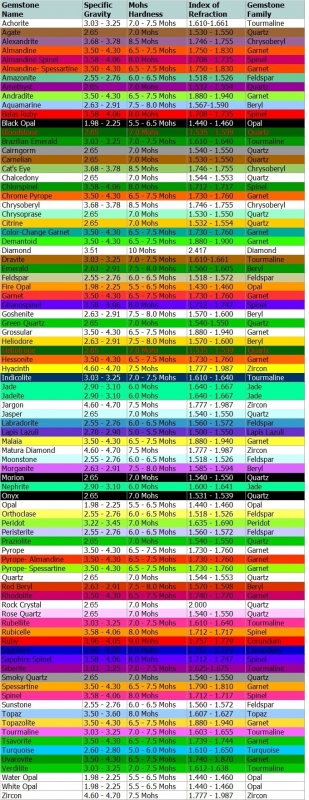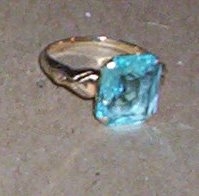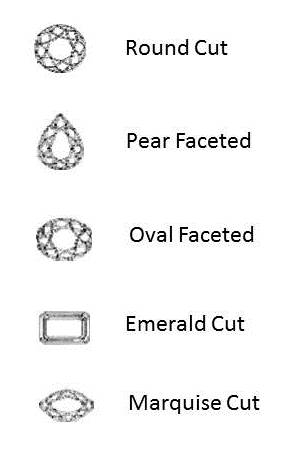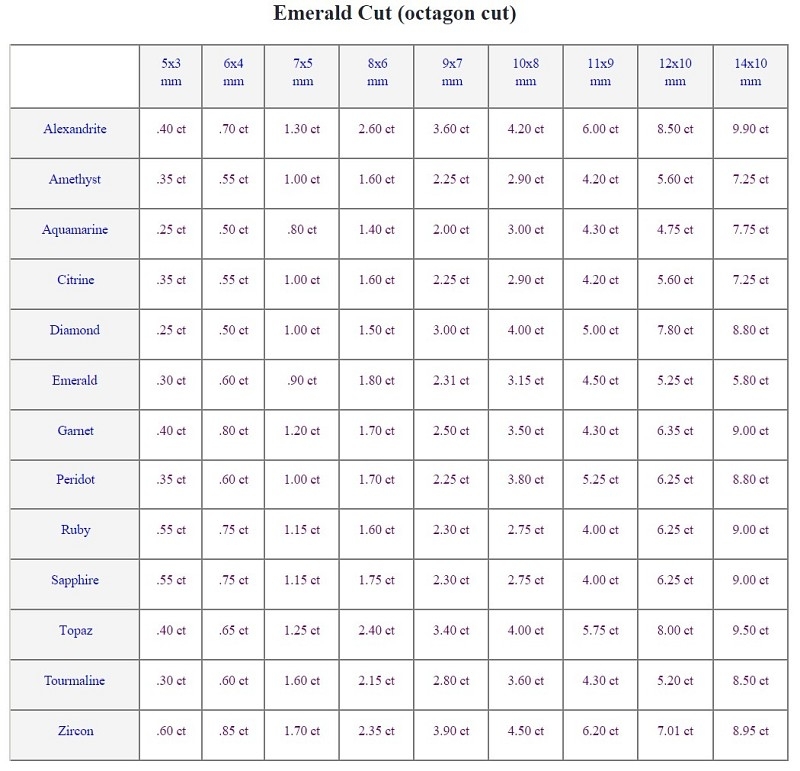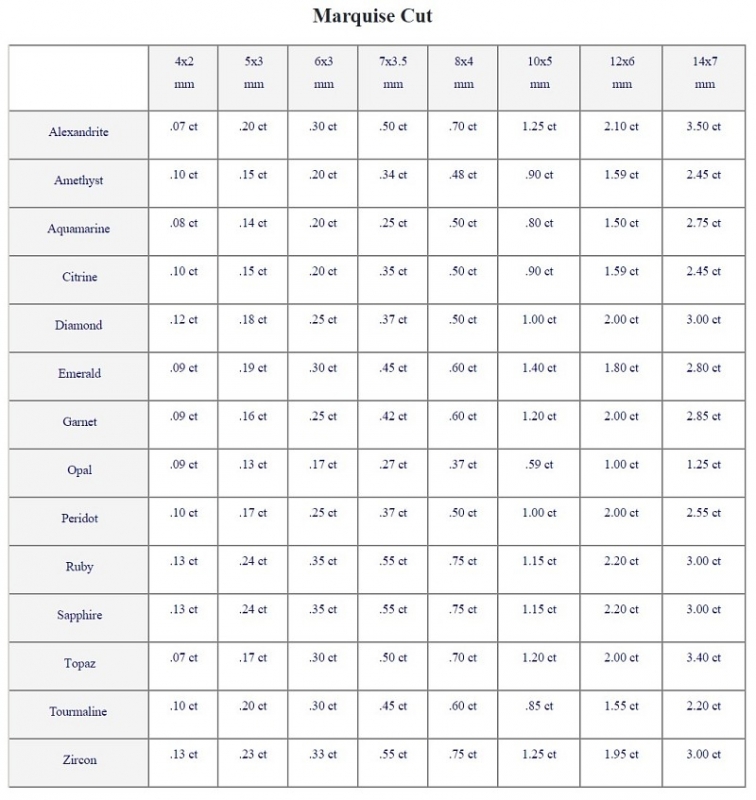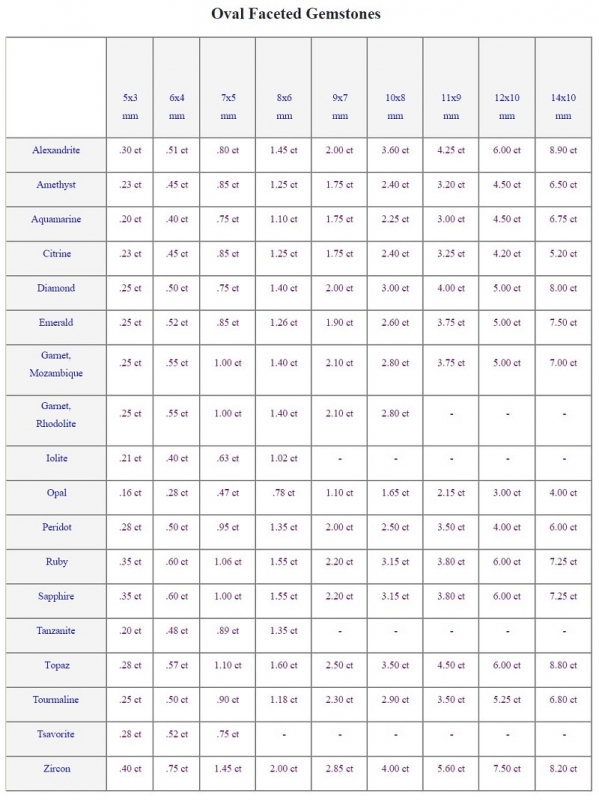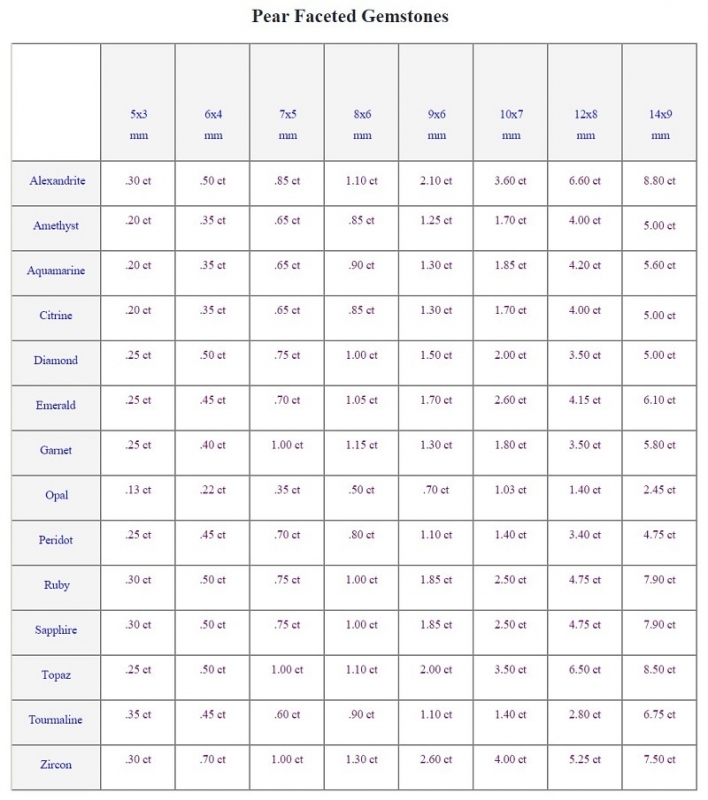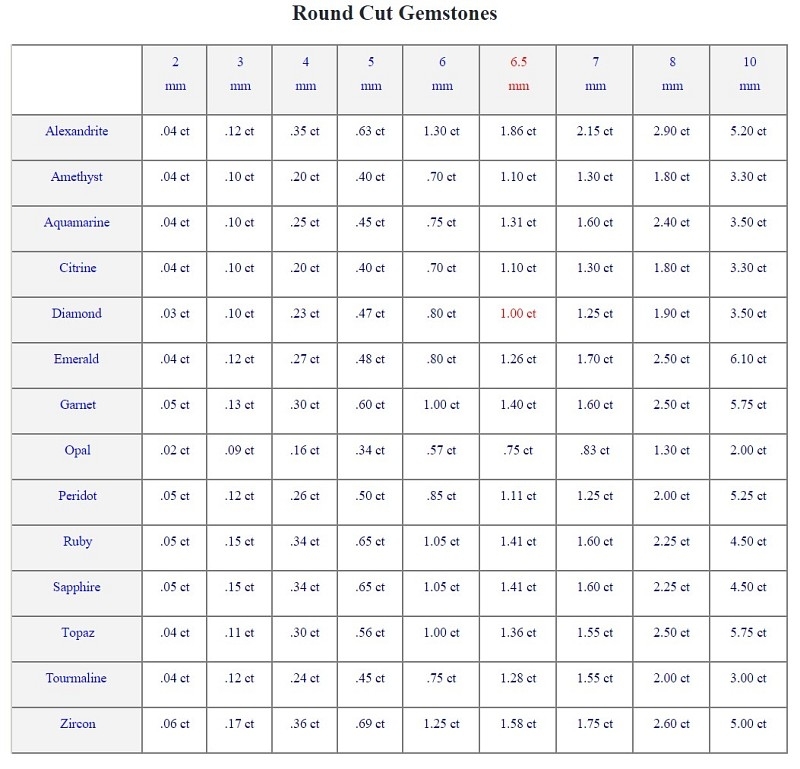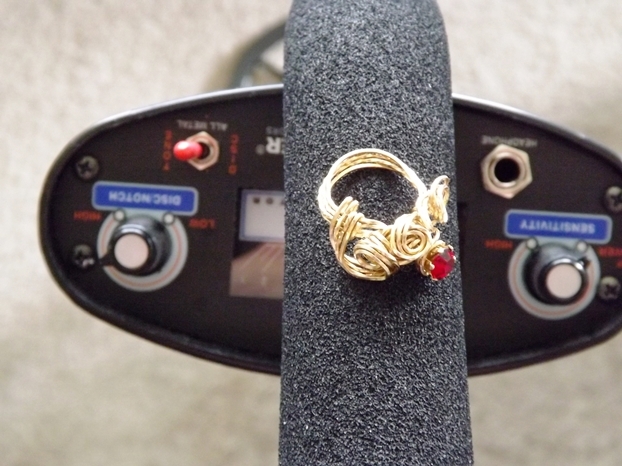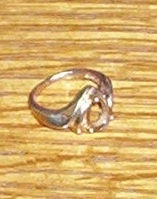-
Posts
616 -
Joined
-
Last visited
Content Type
Forums
Detector Prospector Home
Detector Database
Downloads
Everything posted by Mike Hillis
-
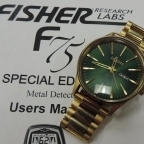
Somebody Should Make A Jewelry Detector
Mike Hillis replied to Steve Herschbach's topic in Metal Detecting For Jewelry
I have two objects that give the same phase response. One is a piece of foil, the other is a little 18kt white gold ring. At high frequency, the phase response is identical. The spectra-graph response is identical...a nice tight signature. What is the difference between the two items? Mass. The ring has a much higher mass than the foil. So a specialty gold jewelry detector needs to be able to capitalize on this difference. High frequencies cannot differentiate mass, yet we still need the higher frequency just because the targets are small. Lower frequencies can differentiate mass. With the V3 as the example unit, 2.5 kHz isn't very responsive to foil. Foil doesn't have the mass to store the eddy currents long enough to report very well. It scatters the spectragraph, and often doesn't even report at all. But the little ring will hold the eddy current and still give a good spectragraph signature. You can see this low frequency effect even on non-round gold items. You can see this effect in the sizing screen in the sizzle of the line before and after the hump. What I am getting at here is that a specialized gold jewelry detector can't be the normal thing we are all used to using. It needs to key into the differences between our trash and our desired targets. Go ahead and give me the high frequency squeal but with that also give me the low frequency mass response. And let me be the one who doing the low frequency dialing. Let me see their responses at the same time. That is just one requirement. I also need to be able to run hot but with low gain, like on the F5 and V3 so that I can key into tiny targets. Give me the additional tiny and large target response filters like the Berkut-5. There is more, but this basically points toward what I'm looking for. HH Mike -

Somebody Should Make A Jewelry Detector
Mike Hillis replied to Steve Herschbach's topic in Metal Detecting For Jewelry
take a look at this... Link deleted since Findmall Forum update broke all old links I agree with you Steve, on the need for a dedicated inland gold jewelry unit. The issue is that there is a mistaken belief that a good relic unit makes a good jewelry unit. Or that a high frequency unit makes a good jewelry hunter. All bogus premises. A inland jewelry hunter's problem statement is, "how do I locate a low to mid range conductive target in a high EMI environment full of low to mid range conductivity non-ferrous trash?" What we are given, for the most part, are what I call trash squealers. High conductive relic units that are good in the ferrous.vs non-ferrous response but poor in the low conductor vs low conductor response. You can find gold with them the same way you find gold with any detector but its not optimized. It squeals, you dig and hope for the best. The V3 is the first unit to come along that actually holds promise for a inland jewelry hunter, yet, as has been said it has a long learning curve. HH Mike -
Pictures of gold makes you antsy to get out doesn't it? Hope the weather holds for this weekend. HH Mike
-
Good start for the year! Do you know what ID number it liked? I'm trying to see how much gold hits as foil range on the F75. HH Mike
-

Between The Cold And Work, I'm Not Getting Out
Mike Hillis replied to Mike Hillis's topic in Metal Detecting For Jewelry
Its a bummer. Be February before I get to swing out side again. Mike -

Between The Cold And Work, I'm Not Getting Out
Mike Hillis replied to Mike Hillis's topic in Metal Detecting For Jewelry
I live close to the foothills of the Sandia Mountains and its normal to get snow on them at nearly 11,000 feet elevation. When the weatherman says snow I figure I'll get an inch or three in my area but it will be clear by the time I get down into the valley. It looks like this one caught us all by surprise and snowed across the whole valley and it was followed by extremely low temperatures. So that measly little 1-1/2" turned the roads into snow pack and ice covered rinks. Basically the more it got drove on , the worse it got. That and the city didn't have the cinders out. I think we just get rain later in the week this week. I don't mind hunting in the snow as long as the ground is dig-able. I have even hunted in blizzard a couple of years ago. But when I have to use a pick to get past the frozen surface I have to wait a bit. HA! HH Mike -
Woke up Friday to snow and packed and icy roads. Got to work before they closed all the roads behind me. I was like 5 minutes ahead of the road closures. If I'd known that I'd stayed home. The temps dropped so low this weekend I didn't get out. Ground would have been frozen. Hoping for a better weekend next week as I found another hot spot to hunt that I think will be productive. Hope the rest of you got out for a chance at silver or gold. HH Mike
-

Suggested Reading For The Jewelry Hunter
Mike Hillis replied to Mike Hillis's topic in Metal Detecting For Jewelry
When 'Fists Full of Gold' goes out of print, that one will top $1000 dollars a copy. I have some decent prospecting books in my library but that book is the best I've read. HH Mike -

Suggested Reading For The Jewelry Hunter
Mike Hillis replied to Mike Hillis's topic in Metal Detecting For Jewelry
That is true. My favorite of the lot is the DFX Gold Methods, mostly because that was the first one I bought but I like all three, they help me mix things together like I did for the ring in the picture. That was from a location I chose off my aerial map and I was literally on site for less than a minute when I popped that up exactly where Clive told me to look. I had thought Clive would write something on the V3 but he leapfrogged to the Deus. HH Mike -

Suggested Reading For The Jewelry Hunter
Mike Hillis replied to Mike Hillis's topic in Metal Detecting For Jewelry
Hi Devilpookie, Yeah, I have seen the prices. Crazy. Personally I would not pay $200 for the Zip Zip. But it is a good book and if you ever run across one at a more affordable price it would be worth it. What I really like about these books is that the information really makes a difference. I'm not an expert, I'm just learning from the experts and my own experience has been that if I digest and follow the information and guide lines contained in them I have better finds more consistently. HH Mike -
I’ve been getting my mind ready for 2017 by re-reading my jewelry hunting textbooks: ‘DFX Gold Methods, Site Reading for Gold and Silver, and the newest one - The Gold Jewelry Hunter’s Handbook. All three of these are written by Clive James Clynick and I personally consider them to be required reading for the dedicated jewelry hunter. So much so that I try to read each of them at least a couple times a year, every year. They contain information for both land and beach hunting but of course I focus on the land hunting part. Of course some of the information is redundant among the three books but there are little gems here and there that make them each worth owning. The information contained in anyone of these three books will guarantee gold in your pouch. I combined the information on page 8 with information on page 18 of the DFX Gold Methods and found this 10K gold ring the first minute on location. When I get into a slump simply re-reading anyone one of them motivate me and put gold back in my pouch. I also periodically re-read Bob Brockett’s, “Taking a Closer Look At Metal Detector Discrimination to help remind me what I’m doing with my discrimination and notch settings. He goes into great detail with pictures and descriptions about what type of objects fall inside discrimination ranges. A great help for making intelligent discrimination decisions. There is one more that I read at least once a year or so, Larry Sallee’s, “The Complete Unabridged Zip Zip”. Most likely not everyone has ground minerals like mine and can probably get along without this one in their library, but my ground signal can mask a small gold response if I set my sensitivity settings too high. Larry reminds me to tune my detectors to get the best audio response possible on my desired target and on how important coil control is on maintaining that best audio response. On some sites I will put a BB on the ground to tune my detector after l discovered that too high a gain setting on my detectors will actually cause the BB signal to break up or disappear. You would be surprised at how much is masked by the ground signal when your sensitivity is set too high in high mineral ground. HH Mike
-
Ok. I got the individual tables posted so with all this information you should be able to identify both the type and weight of any rock you might find in a jewelry item. I got all this information from a gentleman who went by the name, 'Pawnbroker _Bob' on Tom Dankowski's site. Its been a long time, several years, since Pawnbroker _Bob has posted and I haven't been able to get a hold of him for permission to repost on this forum so I am going to link his Forum post here, along with all the table posts I've made so you can find this stuff in one place when you need it. I'll just tell you that its pretty cool to id and calculate your own gem stones, and speak with a little bit of knowledge when you are showing them or trying to sell them. Start with Pawnbroker _Bobs post and then reflect on the tables. I would encourage you to save this info into your own personal libraries. http://www.dankowskidetectors.com/discussions/read.php?2,24105,24105#msg-24105 Genstone Weight Conversion Chart Gemstone Identification Gemstone Weight Calculation Formulas Gemstone and Other Compounds Specific Gravity List and lastly, some more of Pawnbroker _Bob's posts around selling gems. The thread is not long and he is the expert. http://www.dankowskidetectors.com/discussions/read.php?2,23695,23791#msg-23791 There you go. All I know on the subject I got from someone in the know. All in one place. HH Mike
-
Specific gravity list. Compound..............Avg sg. Copal...............1.06 Amber...............1.08 Bakelite............1.26 Jet.................1.30 -1.35 Tortoiseshell.......1.30 Erinoid.............1.33 Celluloid...........1.38 Vegetable Ivory.....1.40 Ivory...............1.80 Kurnakovite.........1.86 Gaylussite..........1.99 Ulexite.............1.95 Meerscham...........2.00 Bone................2.00 Fire Opal...........2.00 Opal................2.10 Chrysocolla.........2.20 Stichtite...........2.2 Silica Glass........2.21 Natrolite...........2.225 Sodalite............2.13 -2.29 Alabaster...........2.3 -2.33 Obsidian............2.3 -2.6 Apophyllite.........2.3 -2.5 Thomsonite..........2.35 Hambergite..........2.35 Petalite............2.39 Mouldavite..........2.35 Obsidian............2.35 Tugtupite...........2.37 -2.57 Hauynite............2.4 Cancrinite..........2.45 Colemanite..........2.42 Leucite.............2.47 Pseudophite.........2.55 Howlite.............2.53 -2.59 Veriscite...........2.55 Elaeolite...........2.55 -2.65 Amazonite...........2.56 -2.58 Orthoclase..........2.56 Moonstone...........2.57 Sanidine............2.57 Moss Agate..........2.58 -2.62 Chrysoprase.........2.58 -2.64 Iolite..............2.59 Bowenite............2.60 Agate...............2.60 -2.65 Chalcedony..........2.60 Vivianite...........2.65 Peristerite.........2.61 -2.63 Aventurine..(fsp)...2.62 -2.65 Scapolite..(pink)...2.63 Sunstone............2.64 Quartz..............2.65 Amethyst............2.63 -2.65 Prasiolite..........2.65 Citrine.............2.65 Synth. Emerald......2.65 Coral...............2.68 Aquamarine..........2.69 Beryl (yellow)......2.69 Labradorite.........2.69 Pseudophite.........2.70 Onyx................2.70 Augelite............2.70 Tiger eye...........2.64 -2.71 Emerald.............2.71 Labradorite.........2.70 Aquamarine..........2.67 -2.71 Scapolite...........2.70 Calcite.............2.71 Pearl (natural).....2.71 Pearl (cultured)....2.75 Talc................2.75 Turquoise...........2.80 Serpentine..........2.4 -2.8 Steatite............2.7 -2.8 Lapis Lazuli........2.80 Beryllonite.........2.82 Jasper..............2.58 -2.91 Conch Pearl.........2.85 Prehnite............2.87 Verdite.............2.90 Pollucite...........2.92 Argonite............2.94 Dolomite............2.85 -2.95 Anhydrite...........2.90 -2.99 Datolite............2.95 Phenakite...........2.96 Nephrite............2.96 Brazilianite........2.99 Nephrite............2.90 -3.04 Danburite...........3.00 -3.07 Tremolite...........2.90 -3.1 Magnesite...........3.00 -3.12 Andalusite..........3.12 -3.18 Amblygonite.........3.03 Tourmaline..........3.02 -3.26 Lazulite............3.09 Euclase.............3.10 Zoisite.............3.10 Andalusite..........3.15 Kunzite.............3.16 -3.2 Hiddenite...........3.16 -3.2 Carborundum.........3.17 Fluorite............3.18 Spodumene...........3.18 Apatite.............3.21 Fibrolite...........3.25 Smaragdite..........3.25 Sillimanite.........3.25 Enstatite...........3.27 Axinite.............3.28 Ekanite.............3.28 Tanzanite...........3.28 -3.35 Diopside............3.29 Dioptase............3.30 Kornerupine.........3.32 Jadeite.............3.34 Peridot.............3.34 Purpurite...........3.35 Zoisite (blue)......3.34 Idocrase............3.38 Rhodizite...........3.40 Epidote.............3.45 Dumortierite........3.26 -3.41 Sinhalite...........3.48 Hypersthene.........3.45 Hemimorphite........3.45 Grossular (massive).3.50 Diamond.............3.52 Sphene..............3.53 Topaz (yellow)......3.53 Topaz (white).......3.56 Periclase (synth)...3.59 Gahnite.............3.58 -3.98 Rhodonite...........3.60 Rhodochrosite.......3.60 Spinel..............3.60 Grossular...........3.64 Benitoite...........3.67 Taaffeite...........3.61 Spinel (synth)......3.63 Hessonite...........3.65 Barytocalcite.......3.66 Benitoite...........3.67 Kyanite.............3.68 Staurolite..........3.70 Azurite.............3.80 Pyrope..............3.70 Chrysoberyl.........3.71 Alexandrite.........3.70 -3.73 Staurolite..........3.75 Uvarovite...........3.77 Malachite...........3.80 Pleonaste...........3.80 Demantoid...........3.82 -3.85 Chalybite...........3.85 Periclass...........3.80 Anatase.............3.88 Gahnospinel.........3.97 Celestite...........3.97 -4.00 Corundum............3.96 -4.01 Sapphire............3.99 -4.00 Ruby................3.97 -4.08 Painite.............4.01 Willemite...........4.03 Sphalerite (blend)..4.09 Glass...............3.15 -4.20 Zircon (green)......4.50 Almandine...........4.97 Spessartine.........4.16 Chalcopyrite........4.20 Rutile (synth)......4.25 Witherite...........4.27 -4.35 Smithsonite.........4.35 Barite..............4.50 YAG.................4.60 Zircon (blue,white).4.69 Chromite............4.1 -4.9 Pyrite..............5.10 Hematite............5.05 Strontium Titanate..5.13 Proustite...........5.57 -5.64 Cubic Zirconia......5.6-5.9 Zincite.............5.66 Crocoite............5.90 -6.1
-
Hereunder the standard formula Round faceted stones: Diameter squared x depth x S.G. x .0018 = ct Oval faceted stones: Length x width x depth x S.G. x .0020 = ct Emerald cut faceted stones: Length x width x depth x S.G. x .0025 = ct Rectangular faceted stones: Length x width x depth x S.G. x .0026 = ct Square cut faceted stones: Length x width x depth x S.G. x .0023 = ct Marquise cut stones, (navette): Length x width x depth x S.G. x .0016 = ct Pear cut stones: Length x width x depth x S.G. x .0018 = ct Square cushions: Diameter squared x depth x S.G. x .0018 = ct Rectangular Cushions: Diameter squared x depth x S.G. x .0022 = ct Square step cut stones: Diameter squared x depth x S.G. x .0023 = ct Rectangular step cut stones: Length x width x depth x S.G. x .0025 = ct Cabochon cut stones: Length x width x depth x S.G. x .0027 = ct Average corner meas & belly meas for cushions, L&W for rectangles, etc..
-
Hi all, This info was shared with me by Pawnbroker_Bob from the Tom Dankowski site in PM's back in 2012. Gemstone Characteristics Table We have compiled a listing of the scientific characteristics of many different gemstones. This is a chart that displays at a glance the important information about each classification of gemstone and it's members. Enjoy! Gemstones This is a fairly comprehensive listing of gemstones with their specific gravity, Mohs hardness, index of refraction and gemstone family classification in alphabetical order. We color coded them to help differentiate between them (these are approximations and subject to error). Specific Gravity: Specific gravity is the number of times heavier a gemstone of any volume is than an equal volume of water; in other words, it is the ratio of the density of the gemstone to the density of water. For all gemstones listed in this table there is a scientifically determined specific gravity. You can use the specific gravity and a couple simple measurements to estimate the carat weight of a stone. Mohs Hardness: Hardness can be tested through scratching. A mineral can only be scratched by a harder substance. Therefore, a relative scale can be established to account for the differences in hardness simply by seeing which mineral scratches another. That is exactly what French mineralogist Friedrich Mohs proposed almost one hundred and seventy years ago. The Mohs Hardness Scale starting with talc at 1 being the softest and ending with diamond at 10 hardest, is universally used around the world as a way of distinguishing minerals. Simply put - the higher the number, the harder the mineral. Index of Refraction: All materials refract light, ie alter its angle. The amount by which light is refracted is an important feature of every gemstone. The measure of a material's refractivity is known as its index of refracton (R.I.). Without going too deeply into physics, light travels at different speeds through different media. When light passes from one medium to another, its path is altered (bent) and it is said to be diffracted. Gemstone Family Classification: The gemstones listed here show every color in the rainbow. Even with such variety of colors, patterns and shapes - they can be broken down into 16 different families based on their chemical composition.
-

Gemstones Weight Conversion Charts
Mike Hillis replied to Mike Hillis's topic in Metal Detecting For Jewelry
They like stones that are big like this. No one buys the little stones. This came out of one my 'patches' -
If you are going to hunt jewelry you need to know how to size your stones. Gemstones Weight Conversion charts All Weights Are Approximate 1 MM = .03937 inch
-
For woodchips I like the Fisher F75. I used to use the Golden uMax with a Cleansweep coil and the F5 with the 10” elliptical stock coil in the woodchips but now that there has been several seasons with new woodchip renewals, the chip depth is too much for the Golden and F5. The F75 has the depth and sensitivity, and the DST feature with F1 frequency has made it useable in the EMI that goes with my woodchip areas. For tiny targets in turf, like chains, I like the Fisher F5. It is hard to find a detector that is good at tiny targets in turf. In order to focus on the tiny targets at grass root level you need to be able to run at low gain settings yet still generate sensitivity to tiny targets. I’m hoping the V3 can transition to this but right now the F5 has been the best. I have my eye on the AKA Berkut 5 for this activity as it has a feature set that would be good for this but I’m not seeing the coils I would want. So far all the available coils are DD and tiny target hunting of this nature works better with concentric coils. At least I think so right now. I'm working on the V3 to turn into my primary turf unit for jewelry. Not there yet but I’m getting close. Right now I’m working on creating a good 2.5 kHz ring program that will let me pick through the light foils. HH Mike
-
Your very own jewelry store. What is cool about this gold ring is not that I found it with a lowly entry level metal detector. What is really cool about THIS gold ring is that I found it where I expected to find it. It is my second gold ring find from this exact location and is my third ring find from the general area. My first ring find at this site was found with a Tesoro Golden uMax while I was proving and validating a ‘loss characteristic’. I had found a ring at a park and had identified it with a particular ‘loss characteristic’ or in other words, “the reason I found it where I found it”. I had subsequently verified this particular ‘loss characteristic’ by looking for and hunting another location that mimicked the first site. The second site produced a nice ladies silver ring. So with this knowledge twice validated under my belt I put my Aerial Map CD in my computer and started making a list of other locations that looked like they could provide the opportunities for this particular ‘loss characteristic’. One of those sites I had identified from my aerial map investigation was this particular site. My first ring find with the Golden uMax at this site thrice validated this particular “reason I found what I found where I found it” , i.e. a loss characteristic, and not just a lost characteristic, but a VALIDATED loss characteristic. At another site I had identified from my map review for this particular ‘loss characteristic’ produced this nice gold ring. Unfortunately I didn’t have the presence of mind to look for the stone I knocked out with my screwdriver when recovering it. The take away: A "validated loss characteristic" is like owning your very own jewelry store. HH Mike
-
Hi All, I like H.Glenn Carson's books. I like the way he tries to get you into the right mindset for what you are hunting for. I wrote this little article several years ago kind of along his view of trying to get you to think rather than just telling you where to go. I find it helps you to own the information. Maybe some will find it helpful. HH Mike So you want to find gold with a metal detector? There are three forms of gold you can find with a metal detector; gold coins, gold nuggets and gold jewelry. I’m going to focus on gold jewelry, and further refine that focus to just gold jewelry found at inland sites, like parks, schools, athletic fields and play grounds. Tip number one: You hunt gold jewelry with your mind. Next time you are out and about, take a look at what type of jewelry people are wearing. What do you see? Who is wearing the gold? What type and size of gold is being worn? What part of the body is it being worn on? Almost everybody is wearing some type of gold jewelry. It may be in the form of a chain around a neck or wrist, to a ring on a finger, to an earring in the ear, but nearly everyone is wearing something. Married couples have wedding bands. Most post adolescent girls, young ladies and women are wearing multiple rings and often bracelets of some sort. The high school and college graduates are wearing class rings. Both female and males are often wearing gold chains. The males often just wear a chain, while the females often wear a chain with a pendant attached to it. You’ll even see ankle bracelets and toe rings. You will notice some cultures wear more than others. Some cultures will wear more and larger gold jewelry. But there are more things to look for than just culture. Pay attention to life style as well. For example the hip hop and rap lifestyles tend to wear bigger and larger jewelry. Can you say Bling Bling? What type and size of gold? The smallest gold is often worn in the ears. Little round studs and small designs, sometimes with stones. Various size loops. Often it is hard to tell but maybe you can notice what type of backing is used to hold them on. Probably easier to look at the women in your own life or visit a jewelry store or the jewelry counter at a big box store and learn about the different types and styles of making earrings stay in your ears. While you are there, study the clasps of chains and bracelets and the various sizes of rings. The girls/women wear the small diameter rings, ring sets, and often they will contain stones. The women will also wear the small gold bracelets, sometime with pendants, sometimes with stones, and small diameter chains, often with pendants. The men will wear the larger rings and the larger chains, and as mentioned above, certain cultures and lifestyles will wear even larger than normal gold. I was in a gold buyers shop a few months back and I saw a gentleman in there that had to have had at least $5,000 dollars worth of gold chain around his neck. Big links in the chains with big pendants in the shape of initials. He wasn’t selling, he was buying. So you have spent some time studying people and the jewelry they wear. And you have made the trip the jewelry counter or store and looked at how they are designed to stay on the body part they are intended to be wore on. You have seen the various earring retention systems; you have looked at the clasps of chains and bracelets. You have noticed the styles and sizes of rings. The next question is, “How is the jewelry separated from its respective body part?” That is a very good question. How do the earrings get out of the ears? How do the chains get off the neck? How do the rings come off the fingers? There are only two answers to that question. 1) They are taken off by the owner on purpose, or 2) They are accidently dislodged somehow. Let’s look at these individually. The first reason identified for jewelry separating from its respective body part was that it is taken off by the wearer on purpose. What is going to cause someone to remove a piece of jewelry? When I was young I remember my mom and grandmother taking off their wedding bands and placing them on the window sill before they did the dishes. Why? The main reason, of course, is for safe keeping. The item is removed so that it wouldn’t get lost or damaged. Let’s take that same thought pattern outside. So now we are outside. Folks are taking their jewelry off for safe keeping but where do they put it? Where is the first place you would put your ring if you took it off for safe keeping? In your pocket of course! What if you didn’t have a pocket? You’d give it to someone else who did have a pocket, or you’d put it somewhere you were pretty sure it would be safe. Somewhere you were confident you wouldn’t lose it, most likely with other stuff that you had to do the same thing with, or you would put it into something else, like a bag you brought with you. The second reason identified for jewelry separating from its owner is by it being accidently dislodged. Let’s think about that. What type of activity does it take to dislodge something that is designed to stay on your body unless you purposely remove it? Let’s use a men’s ring for an example. What type of activity does a man need to be involved in to lose his ring? He either has to have his hand in something that could potentially remove his ring when he removed his hand, or he had to engage in some sort of activity that would cause the ring to leave his finger. What would cause a chain to be dislodged from around a neck? The clasp has to either come open unexpectedly or the chain has to be caught in something that causes it to break. What would cause an earring to leave an ear? It has to lose its fastener, or be caught in something that would pull it from the ear, or both. How is something that is placed in a pocket or bag for safe keeping accidently leave its place of safe keeping? It has to fall out or be spilled out, or be accidently pulled out. Tip number two: Gold has to be hidden from eyesight for us to find it. How come when a piece of jewelry is lost the owner of the jewelry didn’t recover the lost piece? There are only two answers to this question. 1) They either didn’t know they had lost it, and/or, 2) It was lost in some type of media that could hide it from their eyes. There was something that prevented it from being found by only looking for it with their eyes. It could be sand, woodchips, gravel, grass, trash, leaves, anything that once something is dropped onto it or into it that makes it difficult to find with just your eyesight. Tip number three: Learn the loss characteristics of the items you find. Seek the answer to the question, “Why did I find what I found where I found it?” Once you think you have the answer, validate it by hunting other areas where that loss characteristic could be repeated and see if you find jewelry there. A validated loss characteristic is more valuable than the jewelry find itself. A few examples where I have found something and identified the items loss characteristic(s): I found a nice herringbone style 14kt gold chain on an athletic field. It was intact and the clasp was attached to its respective counterpart. The guy would have had to lose his head in order to lose the chain. But here it was down in the grass and there was no severed head with it. So how did it get there? This is an example of an item that was taken off for safekeeping and then lost. It wasn’t torn off, or flew off over his head, this had to come out of a pocket or bag, and I believe it was from a pocket as it wasn’t in a location where bags and such are normally staged. So what activity would normally take place where I found the chain that would cause it to come out of a pocket? Since it was a soccer field, I deduce it was something to do with running or perhaps falling down. I have found many items on athletic fields that were originally placed into a pocket or bag for safe keeping that was then subsequently lost. I found a little 10kt gold chain and pendant with a broken chain in the sand at a school playground. It was quite obvious from the broken chain that it had been torn from a child’s neck in some type of play activity. From the equipment around the find, along with subsequent chain finds in the same area around that equipment I deduce it is a great area for games of tag or some such activity as all the chains I found in that area have been broken. (a validated loss characteristic) I found a nice 14kt gold wedding band with three .20 carat diamonds mounted on it about five inches deep in some woodchips. Studying the situation, it was easy to see that a parent had been sitting on the curbing around the play ground, leaning back with their fingers buried in the loose wood chips watching their children play in the adjoining playground. When they removed their hands from the woodchips the ring was left behind and the parent either didn’t notice the ring was gone or noticed it but couldn’t find it. (validated loss characteristic) I found a nice wide wedding band near a goal post on a soccer field. It had obviously been left for safe keeping in that location, either with other possessions, or by itself and was either not recovered or fell out of a bag when the other possessions were recovered and hidden by the grass. (validated loss characteristic). Ok. So you have figured out the most likely reason a piece of jewelry was lost. Now what? Once it is understood why or how a particular item was lost, the next step is to seek out places where that particular loss characteristic can be repeated. Tip number four: Don’t dig trash, dig gold trash. Gold jewelry is a low conductive target on a metal detector and is found in the same range as aluminum trash. It is often a small target. Remember all those earrings and chains and rings and bracelets you saw at the jewelry counter? Small, low conductive objects that hide in the aluminum trash range can be tedious and hard to find. Even more so if you have to factor in ground minerals that can skew or even hide the signal of the jewelry item. So let’s think about that; small valuable targets mixed in with small aluminum trash that produces the same type readings on your metal detector. That means that to find the gold jewelry you will also have to sort through the trash. Doesn’t sound very promising, does it? Am I saying that to find the gold you have to dig it all? Nope. That is not what I am saying at all. What I am saying is that to find gold jewelry you have to dig all targets that have the highest probability of being gold. Now there are sites like woodchip and sand playground areas where you will want to recover every signal. But to do the same thing in a high use grassy park, athletic field or playground, trying to recover every signal is counterproductive. From your visit to the jewelry counter, you may have noticed that some of the chains have quite a bit of weight to them. A nice gold chain is a good find! Good money! So off I go to hunt chains. I’ve already used my mind, located a promising turf spot to hunt for chains and start digging all the pull tab signals. Hours later I have a hundred plus pull tabs, but no gold chains. Why? I was digging the wrong signals. Pull tabs would be the right targets to recover if I were hunting large rings, but worthless targets to recover if I am hunting gold chains. Especially so if you were in a site that you were confident would produce chains but not large rings. Get the picture? Let’s look at it a little differently. Let’s say that I get to my chain site and start digging all the signals. Now I have a chance to find a chain if it is there, but because I am digging everything I make very little progress on my site coverage, using up energy and time on non-chain targets. I have essentially cut done on my odds of actually finding the target I went out to find. To have the best odds of finding that gold chain I went looking for, I need to focus on signals that could actually be a gold chain and only recover those signals that could actually be a gold chain. Which leads to: Tip number five: the more ground you cover, the better your odds of recovering what you are looking for. By focusing only on the signal I’m after I can cover more ground and increase my odds of actually finding my desired object, which in this example is a gold chain. Tip number six: Gold is where you find it. Gold prospectors have a saying, “gold is where you find it.” That means that you hunt gold where it has been found in the past. Believe it or not, that same saying is true for jewelry. The characteristics that cause a piece of jewelry to be lost and hidden for you to find it with a metal detector are apt to be repeated again and again in the same location. When a gold prospector finds one nugget, he hunts the area carefully again, hoping to find another. When he does find another nugget in the same vicinity, it is called a “nugget patch”. As inland jewelry hunters we, too, are looking for a “patch”. In our case, a patch is a site or location where a particular loss characteristic can repeated again and again. We are not looking so much for that random find but rather that site location where that loss can be repeated again and again. That is a “patch” for a jewelry hunter. A successful jewelry hunter locates patches and then hunts his patches. Many of my jewelry items have come from the same locations that I have hunted again and again, another words, I have found them in my “patches”. Tip number seven: Hunt clad (modern coins) to improve your site reading skills. You say, “Well Mike that is all well and good for you. You have been doing this for a while now and know where to look. What about those of us which are new to the hobby, or maybe coming over to inland jewelry hunting from hunting relics or old coins?” My answer to you is to ‘hunt clad’. Sounds counter intuitive to hunt clad to find gold, but it’s not. Just like the relic hunter hunts for the iron to find the hot spots, so the inland jewelry hunter hunts clad to find the hot spots in parks, athletic fields and school playgrounds. Remember, unlike relics or old coins, jewelry is lost on a daily basis, just like modern clad coins, and often for the same reason. Clad will validate your site reading skills. Recovering the gold: The equipment. If you are going to focus on inland jewelry hunting with a metal detector there are certain features that make it easier to find. Just like any tool, the more appropriate the tool to the task, the easier the task becomes. Working on your car is much easier and efficient with a socket wrench set as compared to having only a pair of vise grips. You could still get the job done with the vise grips in many cases but it would be a tedious and tiring affair. The same thing can apply when it comes to your jewelry hunting tools. You can find jewelry with any metal detector, but it is easier if the metal detector has certain features. The first feature your detector needs is the ability to focus your attention onto your desired target signals. The easiest way to do this is with tone ID. Tone id allows you to discriminate the audio signals with your ears. If you are hunting ladies rings, you have to be able to tell the foil signals apart from all the other responses. Tone Id allows you to do this fast and easily. The better you can focus the tone id onto a certain conductivity range, the better the detector will function for jewelry hunting. A second, and a complimentary feature to tone id is Notch Discrimination. Notch Discrimination is the ability to discriminate out (or in) a range of target signals independent of the base discrimination setting. Again, focus is the key. The more you are focused on the desired signals, the more of the proper signals you will recover for the amount of area searched and the greater will be your success. The third feature is sensitivity to small low conductors. Traditionally this has been accomplished by using higher frequencies units, and is still preferred; however there are some machines on the market today that can give the needed sensitivity with lower frequencies than has been used in the past. Still, the bottom line is that your detector needs to be able to put out some heat on the lower conductive targets. The forth feature is recovery speed. How fast the machine resets after reporting so that you can hear the next target. This is important as the objects you are looking for are lying next to, below, or above other objects that you are not looking for. And they are small. My first gold jewelry find was two gold rings on a large paper clip. The paper clip response nearly completely masked the ring responses but the Fisher CoinStrike I was using at that time had a fast enough response speed that I was able to hear them as distinct, separate signals. I consider those the four most important features a metal detector needs to be a useful gold jewelry hunter. If you live in an area where the ground minerals are influential on signal responses like I do then you have to include ground cancelling features. There are other factors that can make one machine better than another like visual signal presentations, coil selections and such like. But as long as you have a unit that is fairly quick responding and will let you focus on a desired signal and put some heat on it, you are good to go. HH Mike Hillis
-
Lovely pictures. You had fun in 2016! HH Mike


